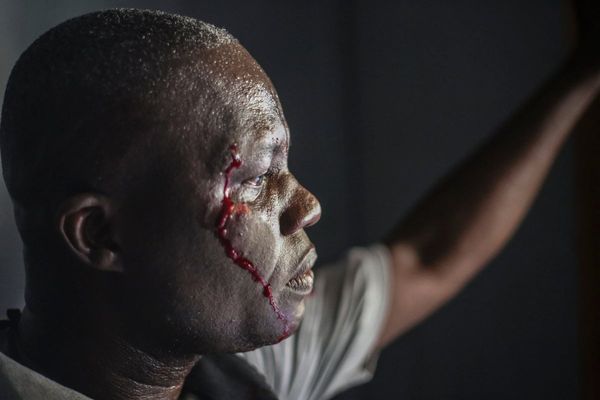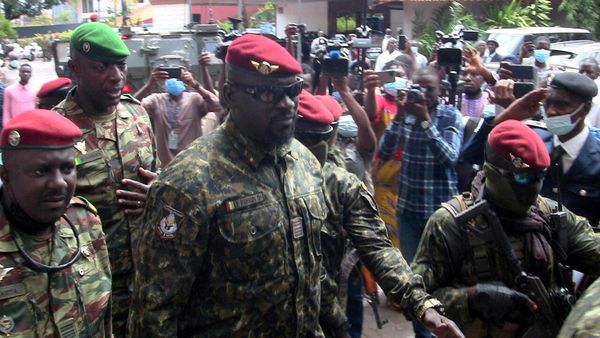
T
he weatherman’s striped tie is still snug on his neck as he starts an evening bath for his three kids, one of whom bolts naked from the bathroom and does a lap around the kitchen before running back, feet slapping on the hardwood floor. “Okay,” Shel Winkley says, walking into the kitchen where his wife is loading the dishwasher. “I love you,” he tells her, and then he walks outside to his gray Prius, gets in, and drives to the TV station. Dinner’s over. Back to work.
It’s warm outside in Bryan, Texas, warmer than usual on this Wednesday night in October, and on KBTX at 10 p.m. Winkley is going to talk about rising temperatures as a symptom of global climate change. The climate crisis, of course, is a divisive issue in America. A little less than a third of adults don’t see a crisis at all; they see a melodrama. Winkley, 36, used to not worry about climate change much either.
A decade ago, Winkley was a few years out of college and focused on doing his job without messing up on air. TV was intense—the hours, the pace, the volume of work—and he was, as he puts it, a “baby deer.” In school he’d certainly learned about the climate, because he had to understand trends in long-term weather in order to issue short-term forecasts. But when class discussions turned to climate change, his meteorology professors talked mostly about natural cycles instead of human causes.
Winkley, now planted back at his desk in front of his three computer monitors, is clicking and clacking, compiling the weather. On the center monitor he’s loaded rows of daily temperature data, which he’s copying one day at a time into a calendar open on the left monitor. In the right corner of the calendar is a big blank space. It’s 8:27 p.m., and in an hour and a half, when the calendar is projected on the studio’s green screen, he’ll stand in front of the blank space. He has the script in his head. (On the right monitor is Twitter; on Twitter are fans, who respond to his tweets with piles of hearts.) He looks at a coming day’s temperature and the number of degrees it’s forecasted to climb above average. “Pff!” he exclaims. “17.” One or two days like that in October, sure, he says, but several days last week have all exceeded the average by 10 degrees or more, which is not normal. “It’s worrisome.”
The room around him is as large as a high-school classroom, and every surface in it seems to gleam: the polished floor, dark as obsidian; the four big cameras on tripods standing in the center of the floor; the five on-air desks ringed in chrome and faux mahogany that read, in block letters, news, sports, pinpoint, weather. TV is a fancy medium, and we like that, don’t we? We like it so much that on average, according to the Bureau of Labor Statistics, we Americans watched TV for more than three hours every day in 2020. While newspapers are folding everywhere (more than 2,100 kaput since 2004), local TV has continued to command our attention like a tennis ball commands a dog. In 2020, local-news stations made a total of $18.4 billion in over-the-air ad revenue. That’s enough money to build, say, our nation’s most advanced aircraft carrier, the USS Gerald R. Ford, and then buy a couple of baseball teams to play on its deck, which would make, in fact, for good TV.
When Winkley finishes his prep for the 10 p.m. broadcast, it’s only 9:23. “Now the question is,” he says to himself, “do I try to bang out a story, or do I play with Instagram?” Both. He starts uploading a behind-the-scenes video montage of him and his team on set doing the news and the weather, and then, begrudgingly, begins writing a story for the station’s website. He writes a headline, deletes it, ponders another headline, and then switches back to the video, which, finally, has uploaded. He watches it again. “Yeah,” he says. “That’ll work.” Then, out of distractions, he resumes writing. “October 2021,” he clacks into the keyboard, “is making a run at one of the warmest ever on record in Bryan–College Station. As of Wednesday”—click-click, clack-clack. And now for a commercial break from our sponsors.

S
o let’s do the math. The number, approximately, is 77 million, almost a third of American adults. That’s how many people don’t worry much or at all about global warming in this country, according to a September 2021 survey. Seventy-seven million adults could populate New York City nearly nine times over, but that’d be a bad idea, considering big chunks of the Big Apple are projected to be permanently flooded by 2100. By then, if we keep cranking out carbon emissions, fires in the mountains of California may have doubled or tripled in size, and heat waves in the Midwest may be killing thousands of people each year.
Seventy-seven million hardly worried or not worried at all, even though disaster is already an endless season. Why won’t these Americans change their minds? One category of American adults (the 8 percent who are “dismissive” of global warming, according to polling by the Climate Change in the American Mind project) may not because the crisis contradicts their constructed reality. These Americans are mostly older, white, Republican men who see themselves as sturdy individuals rather than members of a society; instead of accepting that the planet is warming, these Americans reject facts in favor of conspiracy theories. Many of these Americans are drawn to conservative media, and their consumption of it invigorates their denial, which stimulates their consumption of conservative media, which invigorates their denial.
These Americans, among others, are stuck in what researchers have called “reinforcing spirals.” Social scientists have long assumed that most of the Americans misinformed about climate change were protecting a constructed reality, but that view is shifting. A more recent study suggests that many in this cohort, which could include the “dismissive,” are sincerely interested in the truth. These people aren’t suspicious of the evidence because it contradicts their view of the crisis but because they don’t trust the available messengers, namely the scientific community and the mainstream media. An alternative is partisan media, such as Fox News, but Fox has captured only a fraction of the American public; many more people watch less-partisan TV such as NBC, ABC, and CBS. “Media outlets with a significant partisan or ideological slant,” the study states, “simply do not reach most of the U.S. population.” So these Americans seeking the truth have fallen through the climate cracks.
Until about a decade ago, so had local TV meteorologists like Winkley. At that time, about half of the country’s TV weathercasters either weren’t certain that the world was warming or were certain that it wasn’t. Those who said they’d experienced obstacles to reporting on climate change in part cited problems similar to the public’s today: They doubted the information they were reading, watching, and hearing. They had no trusted messenger, and many were too harried to find one.
In 2010, a group of respected scientists and journalists, some of whom had worked in TV themselves, began trying to earn the trust of TV meteorologists. The group’s nonprofit, Climate Central, along with partner organizations secured a National Science Foundation grant for their program, which started with a single TV meteorologist, Jim Gandy, in South Carolina. (Emerson Collective, which owns The Atlantic, provides funding to Climate Central.) Gandy had been interested in climate change but had never had time to do the research necessary for on-air segments. Every month, Climate Central provided him with localized climate-change content that he could use during broadcasts—graphics, analyses, maps—which was a huge help, he told me. “I couldn’t have done it,” he said, “without Climate Central.” As the nonprofit expanded its efforts to more stations and more meteorologists, its members were careful not to preach policy solutions; instead, they asked broadcasters how they could help them report on climate change. “We never looked at it like, ‘We’re the ones in charge,’” Bernadette Woods Placky, the program’s director, told me. “It was a relationship. It was a partnership.”
By 2012, Climate Central was working with 10 weathercasters. By the end of 2013, it was working with 100, and it had quadrupled its production of localized reports. The number of participating weathercasters continued to grow, and with more exposure to trusted climate-change information, they began to see climate change for what it was. By 2017, 95 percent of TV weathercasters agreed that the climate was indeed changing. By 2020, 80 percent acknowledged that human activity was a major reason. The facts here did what facts sometimes do when people are actually searching for the truth: They changed minds. Now weathercasters, with their eyes open to the crisis, are better positioned than anyone else to guide the remaining Americans through the same transition. One 2013 study, frequently cited, found that the more people liked a TV weathercaster, the more likely they were to be positively influenced by that weathercaster’s discussion of climate change.
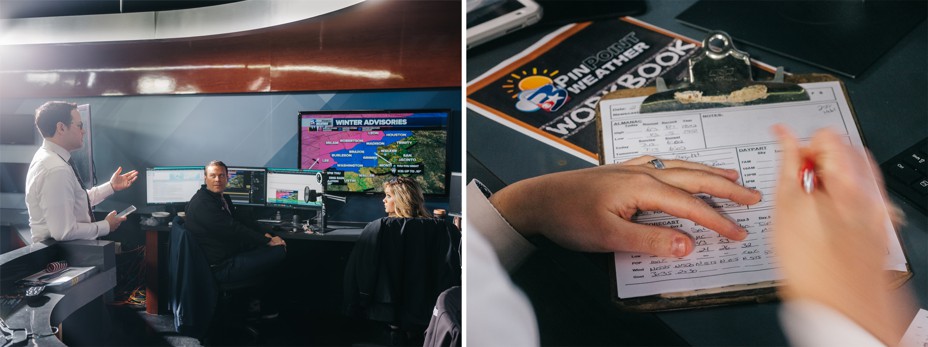
Most Americans typically don’t follow the news until something big happens; once the news cycle is done, surveys show, so are they. Only half of us hear about climate change on the news at least once a month, and only one out of five Americans say they hear about it from people they know in the same time frame. “As a result, it just isn’t a salient or terribly intense concern for many,” John Kotcher, a research assistant professor at the Center for Climate Change Communication at George Mason University, told me. But when Americans do want the news, their local TV station is often their chosen source. There, people they recognize and like tell them about the weather, and, lately, these familiar people have begun mentioning “climate-change this” and “climate-change that,” making a crisis that seemed distant and abstract feel a little more real.
“I think there’s a degree of kinship that comes with that” connection, Kotcher said. “As a result, there’s trust there that isn’t necessarily present with, for example, members of the local university.” Those climate scientists, he said, certainly know more about climate change than the local TV meteorologist; they’re just not visible to the public. Winkley is. People see him on TV. People see him at the county fair. People see him walking on their sidewalks, eating dinner at their diners, buying groceries at their grocery store. “Shel is deeply plugged into this community,” Josh Gorbutt, KBTX’s news director, told me when I visited in October. “He is omnipresent. He turns the lights on in downtown Bryan with Santa Claus every year.” When KBTX canceled its 2020 holiday lighting with Santa because of the pandemic, the station distributed little cardboard cutouts of Winkley beaming under a Santa hat. Viewers sent back pictures of little Winkley in their homes: perched on the mantle, hanging from a Christmas tree, fixed to a menorah. “Shel,” they called it, “on the shelf.”
But Winkley, despite his dad charm and hokey on-air jokes and earnest, obvious joy in breaking down big scientific concepts into little understandable chunks, has a tough audience. Even if he succeeds in localizing the global crisis, in establishing that this rain or that heat wave or these winds are not normal, his audience’s definition of normal can quickly change. Texas is a land of extremes, after all, and weather that initially looks like evidence of climate change can soon become routine: The climate’s not changing. We’ve always had storms like this. And people can only worry so much. Social scientists have a name for this too: “the finite pool of worry.” In that pool are a lot of smaller crises, such as getting the kids to school, getting them COVID-tested so they can even go to school, getting yourself to work, getting the kids home, getting the kids to eat dinner. Getting them, like Winkley was struggling with on that unseasonably warm October night, to take a bath.
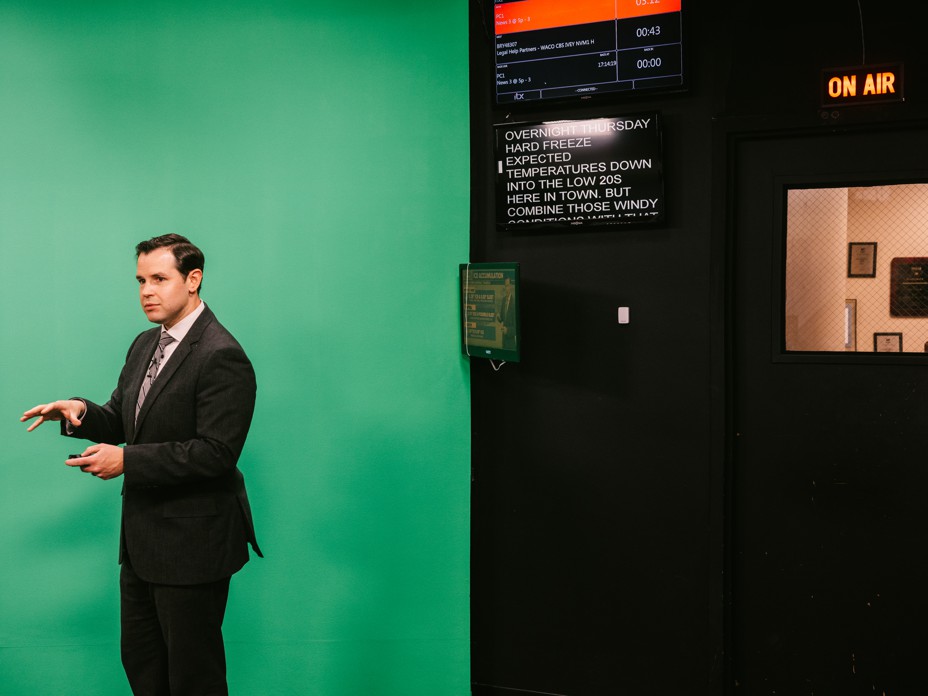
And we’re back! Thanks for staying tuned. While y’all were gone Winkley managed to bang out his story for the TV station’s website, and now Rusty Surette and Karla Castillo have entered the studio through a hidden door and taken their seats behind the anchor desk labeled news. A camera snaps to each of them. Castillo fixes her hair and Surette looks down at a laptop. Winkley pulls on a blue blazer that matches his blue slacks, walks behind the pinpoint weather desk, looks at his watch, dons a serious face, and looks up. They’re live.
“Controversial comments,” Surette says to the camera, “made by a city councilman. What he said and how the councilman’s responding, tonight.”
Castillo: “A Bryan man gets life in prison. Prosecutors say he will never hurt another child.”
Surette: “A drive-through dispute leads to a customer being arrested. Police say she struck a pair of fast-food workers with her car.”
Castillo: “The skyline of College Station will change again. We’ll show you where the newest high-rise is planned.”
Surette: “The Houston Astros are one win away from going back to the World Series after beating the Red Sox in Boston.”
Winkley: “A few of us may drop into a cloud of fog first thing tomorrow morning. Humidity is on the increase across the Brazos Valley, along with temperatures, in the coming days.”
Now a segment on that council member’s controversial comment—“Racist,” an opponent says; “Resign,” says another—as Winkley strolls to the green screen where he’s about to do his forecast.
In a sense, Winkley’s always been a weatherman. He grew up in Lubbock, Texas, so terrified of storms that he’d watch forecasters plot their course county by county on the TV, atlas in his lap. If a storm got close, his family’s power would cut out, and in the dark, he’d have no idea where the tornado was. One morning after a storm, when he was in high school, he walked outside and looked down the road. A few homes had rolled over in the wind. He doesn’t know why, but after that he wasn’t afraid of storms anymore. He was fascinated by them. He began telling people he wanted to be a weatherman.
Winkley has been at KBTX, a CBS affiliate, for 13 years now, and the job still feels important. One time, after he’d finished talking to students at a local school, a mom walked up and thanked him for staying up late so many nights to track storms for them. That touched Winkley. “I like to know that people care,” he told me, because he cares about them. When he talks about climate change on air, he’s simply trying to help Texans prepare for its impacts. Often he won’t even say the words climate change, because he knows that for many of his viewers, they’re trigger words. If they tune him out, he can’t do his job.
Winkley never rejected the reality of climate change, but when he graduated from college in 2007, he didn’t think much about it. Though he’d read articles and studies online, some seemed to contradict one another; most discussed distant phenomena. As the impacts of climate change became clearer, his interest grew. Winkley started at KBTX in 2009, and after a few years he saw that local weather patterns were evolving in ways predicted by climate-change computer models. In 2017, Hurricane Harvey hit Texas, making landfall on the Gulf Coast. The ocean, which rose by up to 12 feet, crashed down streets. Winds, which exceeded 100 miles an hour, toppled houses. Rainfall, which ultimately tallied 50 inches in some areas, scattered the debris throughout communities that had never seen such a disaster. Man, Winkley thought as he reported on the hurricane, we just picked up a year’s worth of rain in three days. What was once an academic curiosity, in his mind, had become an immediate crisis.
Surette and Castillo have finished the news, and the camera on Winkley goes live. “I hope,“ he told me earlier in the night while he was compiling temperature data, “that people know I’m not trying to push an agenda.” Because he isn’t. He is worried. Not the theatrical kind of worry that conservative talk-show hosts mock on prime-time TV. The genuine kind. The kind of worry he felt when he was a kid while outside his house, in the dark, a tornado was flipping homes. Storms may fascinate him now, but climate change, he says, is frightening. “This is the point,” he told me. “We’ve talked about it for a long time—like, we’ve got to keep it below 1.5 degrees Celsius.” But natural disasters are now unnaturally common, “so the question is: Is this what you want to live with, or do you want to live with something worse?”
On air, Winkley begins to speak. “The mornings we’ve had recently where temperatures were nice and cool outside were definitely great to have, especially in the month of October. What you’re looking at here, though—these are our morning temperatures compared to average, so far in the month.”
In the studio, the green screen is still just a green screen, but on the thousands of TVs across 16 counties, people see their friendly weathercaster talking to them from the right-hand corner of the calendar he’d built earlier that night. Nearly every day of the month is colored red: unseasonably high temperatures.
“And you can see most of our mornings have been above average. In fact, for the 12th, 13th, and 14th”—he points at those days then looks into the camera, eyebrows raised—“we’re anywhere from 10 to 15 degrees above average. And I bring that up because we’re falling right back into that trend.”
Beyond the frame, the teleprompter is projecting a script Winkley ad-libbed earlier, but he’s not closely following the text. He normally doesn’t. He tends to improvise the way he is tonight, drawing from some other place, speaking rapidly, blowing through commas and periods and stringing every sentence together with semicolons. He is energized. Management’s never gotten in his way when he wants to talk about climate change. They support him.
Now a red line appears behind him on all the TVs. The line slopes steadily upward.
“And this is a trend, as the climate continues to change, that we continue to see. Our colleagues over at Climate Central have run the numbers of the past 50 years, and since the 1970s, about 18 more days are now considered warmer than average in September, October, and November, which equates to an average of about three and a half degrees warmer now than we were back in the 1970s.
“And we’re going to continue with that warming trend this week,” he says, transitioning flawlessly to the weather forecast—which is what his viewers tuned in for in the first place.
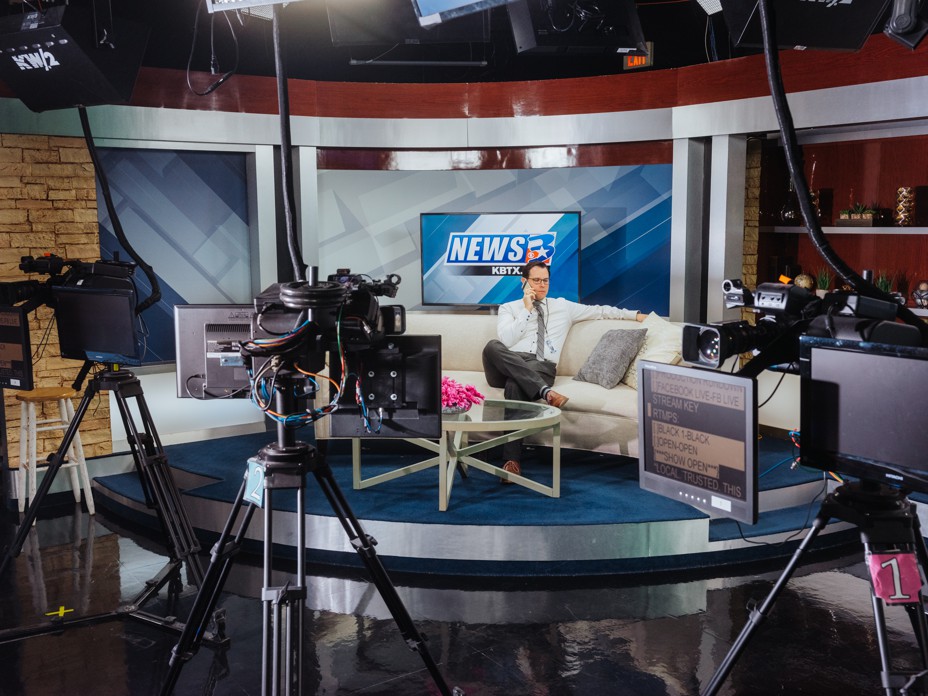
On my last day in Texas, I take the rental car on a drive Hertz would not have liked: down an old asphalt road, then down a sandy road, then through a deep ditch that grabs my bumper, then up a grassy driveway to the top of a steep hill ringed in green trees. The hillside, about 50 miles outside Bryan, is verdant, and on its east-facing flank are three acres of blackberry bushes and peach and plum trees. They’re the pride and livelihood of Steve and Carole Huebner, 72 and 71, who are seated at a table inside, eating blackberry coffee cake and drinking coffee from Styrofoam cups.
Everyone has an opinion on climate change, Steve says. Okay. Up until a few years ago, the way he looked at it was that the climate was cyclical. “That to me was some of my reasons for the changes. Now”—he sighs. “We don’t know. That’s why we rely on Shel.”
“Something’s definitely happening,” Carole says.
“More and more evidence is coming out that says it’s man-made,” Steve says. But there are some groups that say cows are causing it, “and, well, that’s a bunch of crap. Literally.” He raises his eyebrows, punctuating the joke. Steve’s humor is dry.
Years with only a little cold weather are typically unusual, Carole says, but those years are always a big problem because the blackberries and plums and peaches need the cold to fruit.
“But our winters,” Steve says, taking a bite of coffee cake, “have gotten milder. Okay. Some people are going to call that climate change. We may say, ‘Okay, that’s another cyclical pattern.’”
“We’re still kinda not sure,” Carole says.
“Well, the term has been used as a political football,” Steve says, “and that turns us off.”
The politics turn off many Texans. The day before I’d gone to the Brazos Valley fair, where Winkley and a camera operator had done two live segments on the weather. I was walking around with an employee of the TV station who introduced me to two of her friends, both 4-H moms, who were standing together under their pop-up tent. They beamed at me. But then I said, “Hi. My name is Dan Schwartz and I’m with The Atlantic, and I want to talk with you about climate change,” and their smiles fell off their faces like a pair of refrigerator magnets. “Oh,” the TV-station employee said. “I didn’t know that’s what the story was about.”
We are all constrained by psychology, and, boy, is it complicated. But external forces also shape our perceptions of the world. Climate change is a political football only because public figures and corporate agents continue to wrap it in cowhide and call it a hoax. Historically, science and journalism have kept the facts straight, but large pockets of the American public don’t trust those institutions anymore, which leaves them open to less-honest messengers. Fox News, for example, is a longtime broadcaster of climate misinformation (as are the opinion pages of The Wall Street Journal, which, like Fox News, is part of Rupert Murdoch’s empire). In October, Fox Corporation launched Fox Weather, a 24-hour weather platform “expected to change the way Americans consume weather news and analysis,” Fox News announced. After its debut, critics pointed out that Fox Weather seemed to be largely ignoring the role of climate change in its extreme-weather coverage.
Who is honest? What is real? As our emissions continue to warm the world, which messengers will the remaining Americans who are looking for the truth come to trust?
“We read. We see things,” Steve says. We see that the Arctic sea ice is melting, he adds.
TV weathercasters like Winkley?
“It just worries me that the powers that be will go too far in the other direction” as far as banning fossil fuels, Carole says.
Or partisan outlets like Fox News?
“This is Texas, after all.” Steve’s eyes are teasing, but then he’s serious. “We just don’t have enough trusted information to say, ‘Yes, this is what I believe or not.’”
We are seeing a warming trend in October, though, Carole says. (The Huebners have kept a weather station on their hill for about two decades.) “And that concerns me.” Then again, she adds, the temperatures this summer never even broke 100.
“So there you go,” Steve says. “We almost right now are neutral as to what we’re seeing and what it’s caused by.”
He finishes his coffee.
“Cycles,” he says, “and in some ways I’m still leaning that way. So I guess the verdict is still out.”
This Atlantic Planet story was supported by the HHMI Department of Science Education.
